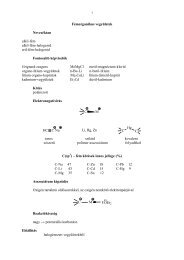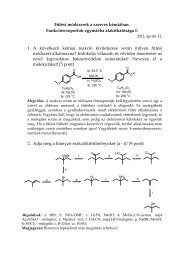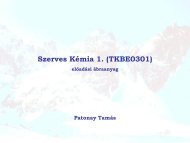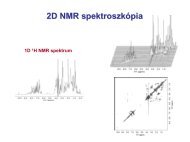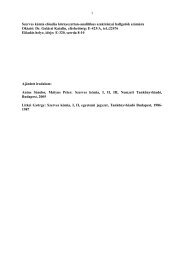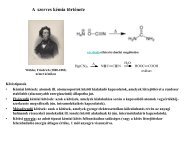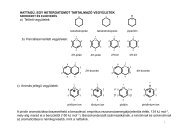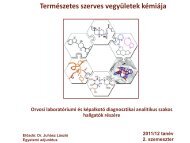Fenilpropanoidok - Szerves Kémiai Tanszék
Fenilpropanoidok - Szerves Kémiai Tanszék
Fenilpropanoidok - Szerves Kémiai Tanszék
You also want an ePaper? Increase the reach of your titles
YUMPU automatically turns print PDFs into web optimized ePapers that Google loves.
<strong>Fenilpropanoidok</strong>(és a sikimisav útvonal más fontosabb vegyületei)
A sikimisav útvonal jelentőségeThe shikimate pathway provides an alternative route to aromatic compounds,particularly the aromatic amino acids L-phenylalanine, L-tyrosine, and L-tryptophan. This pathway is employed by microorganisms and plants, butnot by animals; accordingly, the aromatic amino acids feature among theessential amino acids for man and have to be obtained in the diet.Phenylalanine and tyrosine form the basis of C 6 C 3 phenylpropaneunits found in many natural products, e.g. cinnamic acids,coumarins, lignans, and flavonoids, and along with tryptophan areprecursors of a wide range of alkaloid structures.
A sikimisav bioszintéziseE1: DAHP synthase (aroF, aroG, aroH)E2: 3-dehydroquinate synthase (aro B)E3: 3-dehydroquinase (aro D)E4: shikimate dehydrogenase (aroE)E5: quinate dehydrogenase
A sikimisav forrása és felhasználásaShikimic acid is currently theraw material for synthesis ofthe antiviral drug oseltamivir(Tamiflu®), the main plantsource is fruits of star anise(Illicium verum; Illiciaceae).
Hidroxi-benzoesavak keletkezése a sikimisavhoz vezető köztitermékekbőlE3: 3-dehydroquinase (aro D)E4: shikimate dehydrogenase (aroE)E5: quinate dehydrogenaseE6: 3-dehydroshikimate dehydratase
TanninokGallic acidfeatures as acomponent ofmany tannins,which are plantmaterials that havebeen used forthousands of yearsin the tanning ofanimal hides tomake leatherbecause of theirability to cross-linkprotein molecules.
A sikimisav átalakulása aromás aminosavakká – második szakasz:a korizmasav átalakulása L-fenilalaninná(az L-tirozin képződése analóg útvonalon történik)E1: chorismate mutaseE2: prephenate dehydrataseE3: arogenate dehydrataseE4: prephenate dehydrogenaseE5: arogenate dehydrogenaseE6: phenylpyruvate aminotransferaseE7: prephenate aminotransferaseE8: 4-hydroxyphenylpyruvateaminotransferase
Fahéjsav és kumarinsav képződéseL-Phenylalanine and L-tyrosine,as C 6 C 3 building blocks, areprecursors for a wide range ofnatural products. In plants, afrequent first step is theelimination of ammonia from theside-chain to generate theappropriate trans (E) cinnamicacid. In the case ofphenylalanine, this would givecinnamic acid, whilst tyrosinecould yield 4-coumaric acid.
Hidroxi-fahéjsavak és -fahéjalkoholok
Biológiai metilezés
A lignán- és ligninképződés reakciói
A lignán- ésligninképződésreakciói
A ligninHidroxi-fahéjalkoholok gyököspoliaddíciójával képződikThe plant polymerlignin is astrengtheningmaterial forthe plant cell wallwhich acts as amatrix for cellulosemicrofibrils.In contrast tomost other naturalpolymeric materials,lignin appearsto be devoid ofordered repeatingunits, though some50–70% of thelinkages are of theβ-arylether type.
Benzoesavszármazékok
Az oxigén heterociklusok szerves kémiai rendszerearomásnem aromásNOO O O OOpiríliumkation2H-pirán 4H-pirán tetrahidropiránOO2-pironOO4-piron
<strong>Fenilpropanoidok</strong>, mint az oxigén heterociklusok benzológjaiOOkrománOizokrománOO3-kroménOizokromén2-kroménkromíliumkationOOOOOkromonOOizobenzpiríliumkationOOOkumarinOizokumarinOOOO
Kumarinok képződése fahéjsavakbólCoumarins are widely distributed in plants, both in the free form and as glycosides.Coumarin itself is found in sweet clover (Melilotus alba; Leguminosae/Fabaceae)and contributes to the smell of new-mown hay,
Flavonoidok alapvázai és néhány alapvegyület12Oflavonoidváz1O3izoflavonoidváz23OOOOflavánflavanonflavonOOOOizoflavánOHflavanonolOHflavonolOOneoflavonoidvázO123Oflavíliumkation
Flavonoidok bioszintézise
Flavonoidok bioszintézise (folytatás)
Flavonoidokbioszintézise(folytatás)A flavanon vázátalakulásai
FlavonoidokbiológiaihatásaiConsiderable quantities of flavonoids are consumed daily in ourvegetable diet, so adverse biological effects on man are notparticularly intense. Indeed, there is growing belief that someflavonoids are particularly beneficial, acting as antioxidants andgiving protection against cardiovascular disease, certain forms ofcancer, and, it is claimed, age-related degeneration of cellcomponents. Their polyphenolic nature enables them to scavengeinjurious radicals such as superoxide and hydroxyl radicals.The flavonol glycoside rutin from buckwheat (Fagopyrum esculentum; Polygonaceae)and rue (Ruta graveolens; Rutaceae), and the flavanone glycoside hesperidin fromCitrus peels have been included in dietary supplements as vitamin P and claimed to beof benefit in treating conditions characterized by capillary bleeding; their therapeuticefficacy is far from conclusive. Useful anti-inflammatory properties have beendemonstrated, however.
Flavonoidok biológiai sajátságai és alkalmazásaiNeohesperidin from bitter orange (Citrus aurantium; Rutaceae) and naringin fromgrapefruit peel (Citrus paradisi) are intensely bitter flavanone glycosides. It has beenfound that conversion of these compounds into dihydrochalcones by hydrogenationin alkaline solution (Figure 4.46) produces a remarkable change to their taste, and theproducts are now intensely sweet, being some 300–1000 times as sweet as sucrose.Neohesperidin-dihydrochalcone is used as a non-sugar sweetening agent.
FlavonoidokszintéziséneknéhányalapreakciójaOOHCH 3+CHO1.) KOH/EtOH2.) HO5 ,6 ,4 , 3 , 2 ,H / MeOH vagyNaOAc / MeOHOOH 2(E)-2'-hidroxikalkon6534ONBS/hCCl 4HBrOH2-(R/S)-flavononkat / H 2OOMg / HClflavonMeOH2Hox.OHflaván(2-fenilkromán)10% NaOHOClOflavilium-klorid2-fenil-4-hidroxi-4H-kromén
AntocianidinekszínváltozásaOHOHNaOAc ( HCl)OHOHHOOOHHClHOOOHClcianidin-kloridpiros (pH = 3)OHOOHH 2 OHClOHHOOOHOHOHH 2 OHOOOHOHpszeudobázisszíntelen (pH = 8)OHOHanhidrobázisibolya (pH = 8)OOHHOOONaHClNaClNaOHH 2 Ofenolátkék (pH = 11)O
Izoflavonoidok bioszintézise
Az izoflavon váz előállításaOOHTl(ONO 2 ) 3MeOHOHOCH(OMe) 22'-hidroxikalkondimetilacetál formaOOH / MeOHvagy NaOMeMeOHOOMeMeOHOvegyes acetál formaizoflavonOOOPhPhPhOCH OMeOMeOOMeO OMeNa
Izoflavonoid származékok biológiai hatásaiPterocarpans, e.g. medicarpin from lucerne (Medicago sativa) and pisatin from pea(Pisum sativum), and isoflavans, e.g. vestitol from lucerne, have antifungal activityand form part of the natural defence mechanism against fungal attack in these plants.Simple isoflavones (such as daidzein) and coumestans (such as coumestrol) fromlucerne and clovers (Trifolium species) have sufficient oestrogenic activity to effect thereproduction of grazing animals seriously and are termed phyto-oestrogens.OPhOOOsteochin



